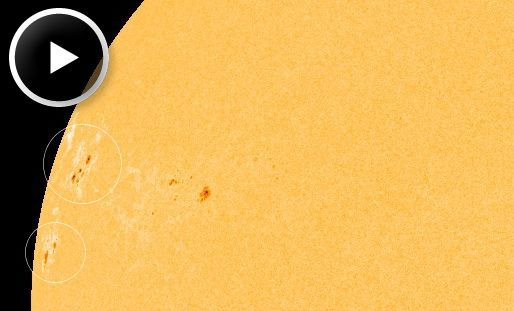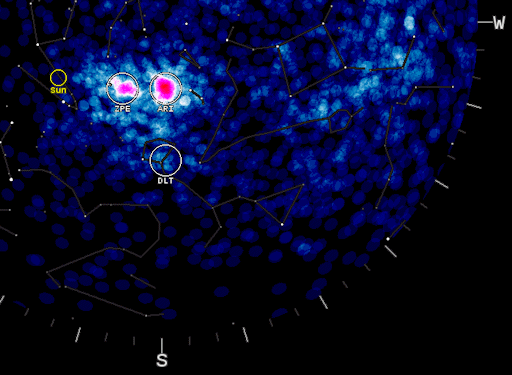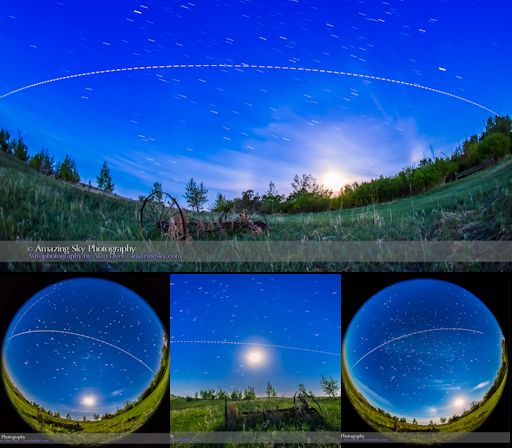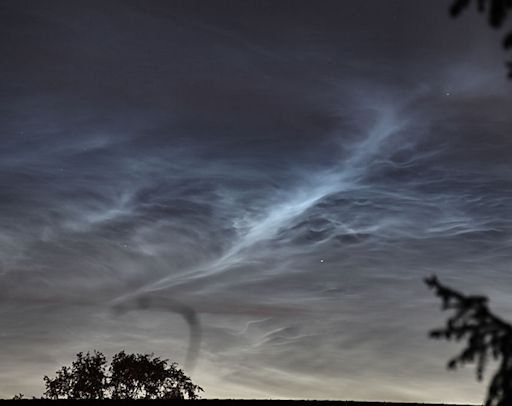Learn to photograph Northern Lights like a pro. Sign up for Peter Rosen's Aurora Photo Courses in Abisko National Park, winner of the TripAdvisor Certificate of Excellence Award 2015. | | |
MORE SUNSPOTS, LESS QUIET: The sun has been quiet for much of the past month. This could change as two new sunspots emerge over the sun's eastern limb. Click to view a 24-hour movie from NASA's Solar Dynamics Observatory:

These new sunspots aren't very large, but at least one of them is active. The dark cores inside the uppermost circle are growing, and on June 4th they unleashed a C8-class solar flare.
Yes, that's right. The sun is so quiet that a C-class flare is newsworthy.
In fact, the C8-class flare of June 4th was almost 10 times stronger than any flare in the past month. This represents a genuine uptick in solar activity. If the development of the sunspot proceeds apace, genuinely strong flares could be in the offing. Stay tuned for less quiet. Solar flare alerts: text, voice
Realtime Space Weather Photo Gallery
DAYLIGHT METEOR SHOWER: On June 4th, the Canadian Meteor Orbit Radar (CMOR) detected a surge in meteor activity. "CMOR has begun to see the ramp up of the Daytime Arietid shower," reports Peter Brown of the University of Western Ontario. The pink "hot spot" in this CMOR sky map shows how the radar echoes are clustered in the constellation Aries--not far from the glaring sun:

"The Arietids are the fifth strongest shower of the year detected by CMOR," says Brown. "They are likely related to a complex of debris streams produced during the breakup of a large comet several millennia ago."
Ironically, most people never notice this relatively intense shower. The reason: It peaks in broad daylight. Compared to the human eye, radars do a much better job detecting meteors through the glare.
"Visual observers may be able to see a handful of Arietids in the hour or so before sunrise over the next week when the shower is at its peak," notes Brown. "These will all be 'Earthgrazers'--that is, meteors which enter at shallow (<10o) angles and streak across very long arcs in the sky. This peculiar visibility is a result of the radiant never getting much above the horizon at northern latitudes before the rising sun washes out the show."
"The shower is unique among CMOR streams in that it has a very broad peak lasting almost five days," adds Brown. "The best time to watch will be any day during the early morning hours of June 6 – June 12."
Extra: Listen to the Arietids on Space Weather Radio!
Realtime Meteor Photo Gallery
SPACE STATION MARATHON: What's better than seeing the International Space Station glide brightly among the stars on a warm summer night? How about seeing it four times? For the next few weeks, sky watchers in the northern hemisphere can catch the ISS making multiple passes over their home towns. Photographer Alan Dyer sends this report from Gleichen, Alberta: "On the night of May 31/June 1, I was able to shoot the passage of the International Space Station on each of four successive orbits, at 90-minute intervals, from dusk to dawn."

"Seeing the space station on not one but two, three, or even four orbits in one night is possible at this time of year near northern summer solstice because the Station is now continuously lit by sunlight -- the Sun never sets from the altitude of the ISS," explains Dyer. "When the ISS should be entering night, sunlight streaming over the north pole still lights the station at its altitude of 400 km."
Satellite enthusiasts call this an "ISS marathon." Find out when to look using Spaceweather.com's Simple Satellite Tracker.
Realtime Space Weather Photo Gallery
NOCTILUCENT CLOUD SIGHTINGS: We often say that noctilucent clouds are "electric blue." One glance at this photo from Kristianstad, Sweden, explains why:

"On Monday night, pale ripples spread across 90 degrees of the northern sky," says photographer Jonas Carlsson. "This is a great beginning to the 2015 season."
Since June began, sky watchers have seen noctilucent clouds over Ireland, Sweden, Denmark, Scotland and Russia. And more are in the offing.... Data from NASA's AIM spacecraft have shown that noctilucent clouds (NLCs) are like a great geophysical light bulb. They turn on every year in late spring, reaching almost full intensity over a period of no more than 5 to 10 days. News flash: the bulb is glowing, and it is definitely electric blue.
Noctilucent clouds first appeared in the 19th century after the eruption of super-volcano Krakatoa. At the time, people thought NLCs were caused by the eruption, but long after Krakatoa's ash settled, the clouds remained. In recent years, NLCs have intensified and spread with sightings as far south as Utah and Colorado. This could be a sign of increasing greenhouse gases in Earth's atmosphere.
Observing tips: Look west 30 to 60 minutes after sunset when the Sun has dipped 6o to 16o below the horizon. If you see luminous blue-white tendrils spreading across the sky, you may have spotted a noctilucent cloud.
Realtime NLC Photo Gallery
Realtime Sprite Photo Gallery
Realtime Aurora Photo Gallery
Every night, a network of NASA all-sky cameras scans the skies above the United States for meteoritic fireballs. Automated software maintained by NASA's Meteoroid Environment Office calculates their orbits, velocity, penetration depth in Earth's atmosphere and many other characteristics. Daily results are presented here on Spaceweather.com.
On Jun. 4, 2015, the network reported 10 fireballs.
(9 sporadics, 1 June mu Cassiopeiid)

In this diagram of the inner solar system, all of the fireball orbits intersect at a single point--Earth. The orbits are color-coded by velocity, from slow (red) to fast (blue). [Larger image] [movies]
Potentially Hazardous Asteroids (
PHAs) are space rocks larger than approximately 100m that can come closer to Earth than 0.05 AU. None of the known PHAs is on a collision course with our planet, although astronomers are finding
new ones all the time.
On June 4, 2015 there were potentially hazardous asteroids.
Notes: LD means "Lunar Distance." 1 LD = 384,401 km, the distance between Earth and the Moon. 1 LD also equals 0.00256 AU. MAG is the visual magnitude of the asteroid on the date of closest approach. | | The official U.S. government space weather bureau |
| | The first place to look for information about sundogs, pillars, rainbows and related phenomena. |
| | Researchers call it a "Hubble for the sun." SDO is the most advanced solar observatory ever. |
| | 3D views of the sun from NASA's Solar and Terrestrial Relations Observatory |
| | Realtime and archival images of the Sun from SOHO. |
| | from the NOAA Space Environment Center |
| | the underlying science of space weather |

